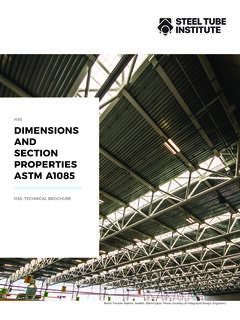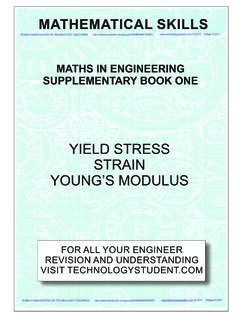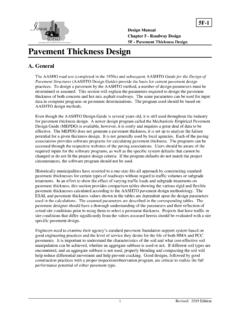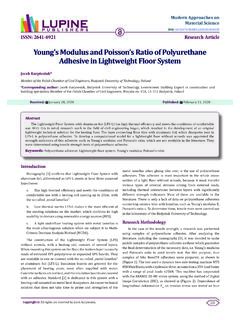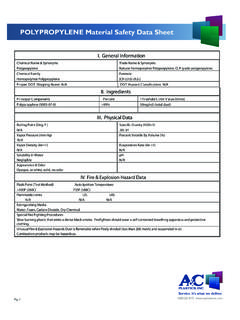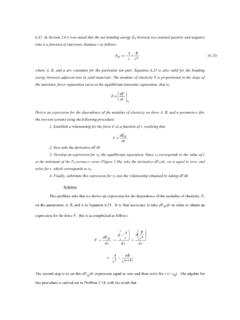Transcription of COMPRESSION MODULUS OF ELASTOMERS
1 BULETINUL INSTITUTULUI POLITEHNIC DIN IA I Publicat de Universitatea Tehnic Gheorghe Asachi din Ia i Tomul LIX (LXIII), Fasc. 2, 2013 Sec ia CONSTRUC II. ARHITECTUR COMPRESSION MODULUS OF ELASTOMERS BY DANIELA OANEA FEDIUC1,*, MIHAI BUDESCU1, VLAD FEDIUC2 and VASILE-MIRCEA VENGHIAC1 Gheorghe Asachi Technical University of Ia i 1 Department of Structural Mechanics 2 Department of Transportation Infrastructure and Foundations Received: May 10, 2013 Accepted for publication: May 22, 2013 Abstract. In civil engineering ELASTOMERS are mainly used in bridge bearings and base isolation bearings for structures located in seismic zones. This paper presents general characteristics of ELASTOMERS , measurements obtained with a Zwick hardness tester, several relationships to determine the COMPRESSION MODULUS of an elastomer layer and experimental determination of COMPRESSION MODULUS on elastomer specimens with different compositions: CR (chloroprene/neoprene rubber); NR (natural rubber); NR/BR (natural rubber/butadiene rubber); NR/BR/SBR+PA/PE Fibres (natural rubber/butadiene rubber/styrene butadiene rubber and polyamide/polyethylene fibres).
2 The COMPRESSION test of elastomer specimens was achieved with a Controlled Electro Mechanism Universal Testing Machine WDW. The aim of this study was to investigate and define the relationship between COMPRESSION and shear MODULUS , hardness and shape factor. The results show reasonable agreement between theoretical and experimental values. Key words: elastomer; Shore hardness; COMPRESSION MODULUS ; shape factor. * Corresponding author: e-mail: 158 Daniela Oanea Fediuc, Mihai Budescu, Vlad Fediuc and Vasile-Mircea Venghiac 1. Introduction The ELASTOMERS are formed from a blend of a base polymer and other chemical substances.
3 This mixture of components is designed to obtain the characteristics required to optimize the performance of products. In the composition of ELASTOMERS there may be added reinforcing agents, curing or vulcanization agents, activators, plasticizers, accelerators, anti-oxidants or anti-radiation additives. There can be made a lot of combinations; ISO 1629 identifies approximately 25 types of ELASTOMERS . In practice, the performance level of ELASTOMERS is estimated by hardness, elastic moduli, resistance to various stresses, abrasion, oils, aging, etc. ELASTOMERS are materials that do not respect the Hooke s law, the deformation is not directly proportional to the applied load.
4 ELASTOMERS have properties similar to viscoelastic materials. Compared to conventional materials used in technical engineering, the deformation mechanism of ELASTOMERS varies greatly. Poisson s ratio of ELASTOMERS is , so it behaves like a liquid and the relationship between the elastic moduli is E = 3G. ELASTOMERS have many characteristics: energy absorption, flexibility, high elasticity, long service life, ability to protect against moisture, pressure and heat, non-toxic properties, variable stiffness, good dielectric properties. ELASTOMERS can be glued on different synthetic materials, have good qualities of bending at low temperatures, are cheap and can be obtained in a wide range of hardness values.
5 ELASTOMERS are damaged when exposed to the oils, fuels, solvents, hydraulic fluids and have low resistance to petroleum products and organic chemicals. If special additives are not used, ELASTOMERS present a low resistance to sunlight, oxygen, ozone and high temperature. 2. ELASTOMERS Hardness Hardness is the property of a material that expresses the degree of resistance to scratching, puncturing or deformation. The hardness is measured in degrees, either Shore Hardness, International Rubber Hardness (IRHD) or British Standard (BS), (Aiken et al., 1989). In order to determine the hardness of ELASTOMERS the Shore test, named after Albert F.
6 Shore, is used. Shore is the one who suggested this test in 1907. The test is made with a measuring device called durometer and the Shore hardness is a number comprised between 0 and 100 defined in many standards such as ASTM D 2240:2003, BS 903:1997, ISO 7619:2004 (Giannakopoulos et al., 2009). Bul. Inst. Polit. Ia i, t. LIX (LXIII), f. 2, 2013 159 To determine the hardness with the Zwick/Roell hardness tester (Fig. 1), the standard specimen should have a minimum thickness of 6 mm and it should not be subjected to mechanical stress. Fig. 1 The Shore hardness test. According SR ISO 7619-1:2011, the measurement of an elastomer hardness depends on several factors namely: the elastic MODULUS and the viscoelastic properties of the elastomer, the thickness of the test sample, the geometry of the indenter, the pressure exerted, the pressure increase rate and the interval at which the hardness is recorded (SR ISO 7619-1:2011).
7 The Shore hardness test was carried out on four elastomer specimens with different compositions: a) CR chloroprene/neoprene rubber; b) NR natural rubber; c) NR/BR natural rubber/butadiene rubber; d) NR/BR/SBR+PA/PE fibres natural rubber/butadiene rubber/sty-rene butadiene rubber and polyamide/polyethylene fibres. The materials were provided by FREYROM , which is the manufacturer of bearings for seismic base isolation and bearings for bridges. The specimens have a diameter of mm and a thickness of 13 mm (Fig. 2). Fig. 2 The elastomer specimens. The test result for hardness was the arithmetic mean of five measurements at different positions on the sample (SR ISO 7619-1:2011).
8 160 Daniela Oanea Fediuc, Mihai Budescu, Vlad Fediuc and Vasile-Mircea Venghiac In Table 1 the hardness values, in Shore A degrees for the four elastomer specimens, are presented. Table 1 Values of Shore A Hardness CR NR NR/BR NR/BR/SBR +PA/PE fibres64 65 63 65 3. COMPRESSION MODULUS Over the years, several relationships have been proposed to determine the COMPRESSION MODULUS of an elastomer layer which has both sides provided with plates (the addition of metal plates prevent the deformations at the contact surface). The first relationship was proposed by Rocard in 1937 for very small and very large values of shape factor (Aiken et al.)
9 , 1989) 2211221321ckSEGSkS +=+ + , (1) where: G is the shear MODULUS , k1 = ; k2 = 4 their values depend on the variation of shape factor; S the shape factor. The shape factor for an elastomer layer was first defined by Keys in 1937 (Aiken et al., 1989) loaded areaforce free areaS= . (2) The shape factor for a circular layer of radius r and thickness t is 222rrSrhh ==. (3) The second relationship was proposed by Gent and Lindley in 1959 (Aiken et al., 1989; Gent, 2001; Kelly, 2001), 220(1 2)cEEkS=+, (4) where: E0 is Young s MODULUS , E0 = 3G for unfilled, low-damping ELASTOMERS and E0 = 4G for high-damping ELASTOMERS with carbon black filler; k the material modifying factor, determined experimentally.
10 Bul. Inst. Polit. Ia i, t. LIX (LXIII), f. 2, 2013 161 The elastic moduli and the material modifying factor of ELASTOMERS vary depending on the material hardness (Fig. 3), (Bauman, 2008). Fig. 3 The variation of elastic moduli vs. the elastomer hardness. The values of Young s MODULUS depending on the two scales of hardness, namely Shore A and IRHD, are illustrated in Fig. 4 (Gent, 2001). Fig. 4 The variation of Young s MODULUS vs. the elastomer hardness degrees (Shore and IRHD). The third relationship to determine the COMPRESSION MODULUS is described by Derham for values of the shape factor S > 3 (Aiken et al., 1989) (5) The fourth relationship belongs to Derham who studied eq.

